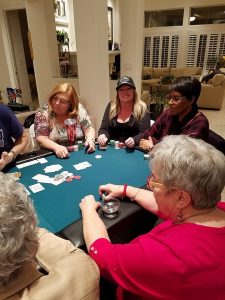19 February 2018

Thousands of women play poker. Why don’t we see more women at the tables more than 10 years after the poker boom?
My story in poker is similar to many women’s story. As a child, poker was played as a family pastime. We played mostly 7 card stud around the kitchen table with my siblings, and on rare occasions, my father.
The one thing poker did was open conversation time among us which I think holds true for many families to this day. It’s because of this style of poker play, I’m convinced women everywhere would love the game. Who doesn’t like to hang out with good friends, snack on some good eats, play a fun game and catch up? Um, pretty much everyone.
So how do we introduce women to poker?
There is a long history of women getting together to play games. Bridge, bunco, mahjong, and more. For some reason, poker isn’t as warm and fuzzy as other games. Perhaps because of the gambling aspect of the game? Maybe. However, poker is a wonderful game, even when played for tokens (chips) and not real money. Many of my non-poker playing friends are often very resistant to trying to learn poker despite the fact that most of the time they end up loving the game once I get them to play it.
So how do we start?
Host a newbie game. Invite a group of your friends to “play a new game”. When they find out it’s poker, they may roll their eyes, but hey, they are there already and usually means they are committed to learn what you have to share – even if it’s this one time!
Make it fun.
Provide snacks and drinks. Or make your gathering a pot luck and let everyone know the theme of the evening. I often host my game nights with “social time” before the game and on breaks. Helps to introduce everyone if there are new faces in the group. (Provide name tags! Makes it much easier around the table if you know who is seated with you.)
You’ll need a few supplies. The following is what I recommend. (You can often find poker set ups in places like Craigslist or Facebook Marketplace fairly inexpensively. Or, borrow a set up from a friend.)
Poker Chips:
I often find the best number of chips is 50 chips per player. In the beginning, you can make the denomination of the chips, no matter what color they are, $1 per chip (fake money). In later games, introduce the different denominations used in the game. Typically $1 for white, $5 for red, $10 for blue, $25 for green and $100 for black. Again, keep it simple with one or two color denominations until people are used to “betting” with them. For example, you can use $1 for white chips and $2 for every other color denominations.
Playing Cards:
You can find new decks of playing cards at the dollar store. Use traditional decks of cards. You’ll need one or two decks per table, and I strongly suggest you be “the dealer” for the night so you can facilitate the game instead of trying to be a player.
Dealer Buttons:
Have a dealer button on every table. You can buy actual “dealer” buttons, or you can be creative and use something unique that “acts” as the dealer button. It can be a small coin, or token. I recommend something flat so it moves easily from spot to spot with every new hand dealt. The dealer button is used to keep track of the “dealer” and your players need to understand the importance of that position when you share the “rules of play”.
Have a Quick Lesson:
Poker is one of those games that is fairly quick to learn, but a life time to master. You’re not using this game night to teach all the nuances of poker… just the basics. Like teaching someone chess for the first time. Just show them what the pieces are used for and how to win.
Lesson Supplies – the Rules:
I did a quick search for “Poker Cheat Sheets” and found loads of great sites offering a printable “one sheet” that helps new players understand hand rankings, how to bet, etc. I particularly like this one located at How to Play Poker Info. It’s colorful and simple to follow. Print a sheet for every player seated at the table.
Play!
Let everyone try their hand at the game. Do a few practice rounds exposing everyone’s cards and explain who has the “best hand” and the betting patterns. Then let them try playing on their own. Perhaps you can provide some small prizes for the players who wind up with the most chips for the night?
Remember, this is often the first exposure to the game. It’s not meant to be a serious experience. Have fun, answer questions and most of all, encourage them to play again!
With most things, it takes baby steps. If we all invite, mentor and support other women to play this game we love, we can change the face of the game. Start with this level of sharing, and when your friends are ready, take them to a poker room and support them while they get the feel for that next step. Who knows, you may be introducing the next WSOP bracelet winner to the game!
Author – Lupe Soto, WPA President

